
Wife number four, but so much more
Anne of Cleves was Queen of England and Henry VIII's fourth wife for just over six months. Disregarded by some historians as the 'ugly one' and the subject of a much-discussed portrait by renowned court painter Hans Holbein, for many she was a brief footnote in Henry VIII's quest to secure the Tudor dynasty. But there is more to her story than meets the eye.
How did Anne of Cleves' status change from being the King's wife to the so-called 'King's Sister'? Not just 'divorced', Anne survived, and even thrived, in the cut-throat Tudor court.
Header image: Portrait of Anne of Cleves (1515-57), Hans Holbein the Younger, © Louvre, Paris/Bridgeman Images
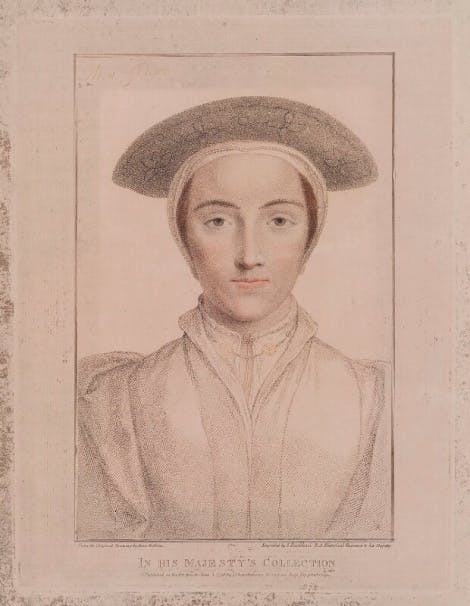
Image: An engraving called Anne of Cleves by Francesco Bartolozzi, after Hans Holbein the Younger, © National Portrait Gallery, London
Anne of Cleves' early life
Born in Dusseldorf in 1515, Anne of Cleves was the daughter of Maria of Julich-Berg and John III, Duke of Cleves. Her traditional birthdate is thought to be 22 September 1515, although some historians have suggested a date in June or July. Anne had three siblings: a brother Wilhelm and two sisters, Sibylla, and Amelia.
Anne grew up in Cleves, a small state in modern-day Germany inside the Holy Roman Empire. Despite its small size, Cleves was a prestigious and respected player in European politics.
Sadly, we know little about Anne's early life. She was close to her mother, who oversaw her education by preparing her to succeed as a German noblewoman. This was a very different upbringing to most women in the Tudor Court. Anne learned to read and write in German, as well as practical household management skills such as cooking and needlework. However, unlike English ladies, Anne did not learn to dance or play music.

Image: Henry VIII by an unknown artist, based on a work of c.1542. © National Portrait Gallery, London
Why did Henry VIII marry Anne of Cleves?
In 1537, Henry VIII's third Queen, Jane Seymour died shortly after giving birth to Prince Edward – Henry's long-awaited male heir and the future Edward VI.
But one son was not enough for the King, who only inherited the throne himself after the early death of his older brother, Prince Arthur. Henry was obsessed with dynastic security and desperately wanted a new queen to provide another son.
Meanwhile, England was politically and religiously isolated. In 1531, the King had broken ties with the Roman Catholic Church and declared himself the Supreme Head of the Church of England, so he could annul his marriage to his first Queen, Katherine of Aragon.
This religious split left England vulnerable against a new alliance between Catholic France and Spain. Through marriage, Henry hoped to strengthen his position by allying with other countries that also challenged the Pope's authority.
The great task of royal matchmaker fell to Henry's chief minister, Thomas Cromwell, who eventually set his sights on Anne of Cleves.
Cleves, like England, was a Catholic state open to religious reform. Anne's brother-in-law even led a league of united German Protestant States that challenged the Catholic Holy Roman Empire. In Cleves, Cromwell found a country with a similar religious and political outlook to England.
Anne, now 23 years old, had been engaged to the Duke of Lorraine since she was 11. However, nothing had come of the match and her family assured Cromwell that Anne was free to marry. Just to be sure, her younger sister Amelia was also brought into negotiations.
Read more: A history of royal weddings
Anne of Cleves' Holbein portrait
When choosing his future bride, Henry was not prepared to rely on his ambassadors' word alone. Instead, the King sent his court painter Hans Holbein to create Anne and Amelia's portraits.
Holbein was renowned for capturing famous figures in the Tudor court, including Jane Seymour and possibly her predecessor, Anne Boleyn. Now, his artist's eye was entrusted to paint Henry's next Queen.

Image: Portrait of Anne of Cleves (1515-57), Hans Holbein the Younger, © Louvre, Paris/Bridgeman Images
The portrait of Anne that Holbein sent to Henry VIII is thought to be this one, now held at the Louvre. Anne is dressed in the popular fashions of Cleves, wearing rich red and gold fabrics with an ornate headdress and fine jewels around her neck. Some historians note that her fabulous, embellished clothes dominate the frame instead of her face. Staring straight ahead, Anne looks coolly at the viewer with her hands clasped in composure.
Holbein's portrait made up the King’s mind. Reassured, Henry finally approved the match and within a few weeks, the fateful marriage contract was signed.
Anne comes to England
We don't know how Anne felt about her engagement to Henry. Their 24-year age gap was not uncommon at this time, but the couple had never met and didn’t even speak the same language. Add to this Henry's reputation from his previous marriages, and we might imagine some apprehension on Anne's part.
Anne left Cleves in the autumn of 1539 and reached English-controlled Calais on 11 December 1539, aged 24. While she waited to cross the Channel, Anne asked through her interpreter to learn one of Henry's favourite card games and took dinner with her English hosts – perhaps to prepare for her new life.
Anne arrived in Dover on 27 December and was accompanied north to Rochester. She rested there a few days before her journey to London, where Anne was told she would finally meet the King.
Read more: Inside the Tudor queens' baggage train
An embarrasing first meeting
When Henry heard that Anne of Cleves had arrived, he and several Gentlemen of the Privy Chamber rode to Rochester to surprise her. On New Year’s Day, 1540, he dressed in disguise, wearing a ‘marbled’ or coloured cloak, and prepared to meet his new Queen.
Meetings in disguise were a romantic tradition, based in French customs of chivalry - a code of conduct that medieval knights were expected to follow. This tradition was popular with Henry and the Tudor court, meant to demonstrate ‘true love’. Ideally, Anne would have either recognised Henry, or been drawn to him instinctively. It was supposed to be love at first sight.
But the meeting did not go well. When Henry burst into the room, Anne did not recognise him. Some accounts said she ignored him or even pushed her fiancé away – a great insult to the proud English King.
Anne of Cleves marries an unhappy Henry
After their first meeting, Henry was disappointed and told Cromwell he did not want to marry Anne. He hoped that her previous engagement to the Duke of Lorraine might prevent the match, but Anne’s advisors insisted that she was free to marry. Anxious not to lose the important political alliance with Cleves, Henry had no choice but to go through with the marriage.
Anne of Cleves married Henry VIII at Greenwich Palace on 6 January 1540. Her wedding ring was inscribed with her personal motto, 'God send me and keep me well'. Publicly, the royal wedding was celebrated with pageantry and splendour, but behind closed doors the relationship was already a disaster.
Things went from bad to worse on their wedding night. In the morning, Henry was said to have told Cromwell that 'I liked her before not well, but now I like her much worse’ and that they were unable to have sexual intercourse (known as consummation) to legalise their union.
Perhaps recognising her situation, Anne reportedly tried asking Cromwell for advice in the following months. However, Cromwell was frightened of upsetting the King and refused to see her.
Read more: Thomas Cromwell's fateful match-making
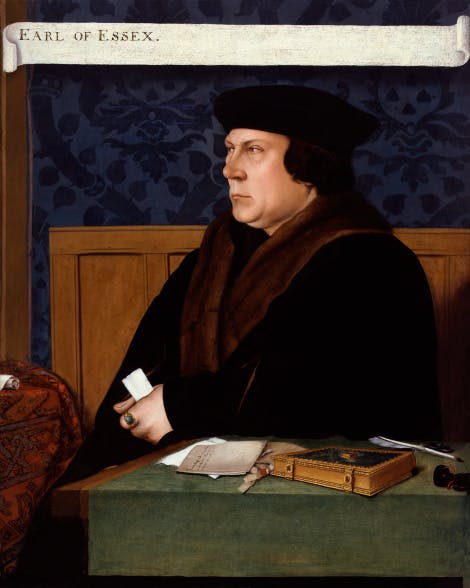
Image below: Thomas Cromwell, Earl of Essex, after Hans Holbein the Younger. © National Portrait Gallery, London
Many times, his majesty has declared unto him that his nature has abhorred her ever since, so far that if his grace would... go about to have a do with her, his highness verily thinks that his nature would not consent to do so.
Thomas Cromwell
Henry VIII 'divorces' Anne of Cleves
Thomas Cromwell wanted to break off the match as quickly as possible. In July 1540, he, Henry, and other eyewitnesses testified to an assembly of Archbishops that the marriage was non-consensual (at least, on Henry's side) and unconsummated. Anne was not invited to testify.
Anne of Cleves and Henry VIII's marriage was formally annulled on 9 July 1540. Unlike divorce, which was rare in England in the Tudor period, an annulment declared that the marriage had never been valid or binding.
Anne was only formally told of the annulment three days before its approval. Henry's officials reported she heard the news calmly and 'without any alteration of countenance'. Yet privately other observers, including Karl Harst, a diplomat who accompanied Anne from Cleves, tell us she was frightened — both for her position and her life. She knew what had happened to Henry's previous queens — the discarded Katherine of Aragon and the executed Anne Boleyn. Other eyewitnesses comforted Anne, recognising that she took the matter 'heavily', and reassured her that the King meant her no harm.
Once the news sunk in, Anne stayed calm. Keeping whatever private thoughts and feelings she had to herself, she wisely accepted the annulment without a fight.
Why did Henry and Anne's marriage fail?
Historians have tended to focus on Anne's appearance. Some have accused Holbein’s portrait of exaggerating her beauty, since the King said he was not attracted to her despite initially approving the match.
However, while Henry complained that Anne was 'nothing so fair as hath been reported', contemporary accounts don’t accuse Holbein of misrepresenting the King's bride-to-be. In fact, Henry's ambassador in Cleves wrote that Holbein had 'expressed [Anne's] image very lively' — suggesting his portrait had a pleasing likeness to the real woman.
Henry and Cromwell also used cruel and graphic descriptions of Anne’s body to explain why their marriage was unconsummated. These descriptions predictably direct the blame firmly away from the King. After all, questioning Henry's ability to consummate the marriage would have insulted his pride and masculinity.
While some eyewitness accounts mocked Anne's foreign clothes and manners, infamous nicknames such as 'the Flanders Mare' were first recorded much later, in the 17th century.
Instead of Anne's looks, historians have suggested other factors:
- The couple lacked both personal and romantic chemistry. This may have been influenced by the bad first impression made at Rochester.
- Anne and Henry were separated by language and culture. For example, Anne’s upbringing meant that she did not share the English court’s love for music and dance.
- The Catholic alliance between France and Spain had faded, reducing the political importance of Anne and Henry’s marriage.
- The King preferred to choose his own lovers. Henry felt that Cromwell had forced Anne upon him, and his eye had already wandered to Catherine Howard, the woman who would become his fifth queen.
The King's 'sister'
Grateful for Anne's cooperation, and probably to avoid conflict with her family, Henry presented his former Queen with a generous settlement.
The King promised Anne that if she remained in England, she would be granted the honoured title of 'the King’s Sister'. Anne would be bestowed with vast amounts of property, such as Henry VII's Richmond Palace and later Hever Castle, the former childhood home of Anne Boleyn. Anne also received an annual income of £500 as well as revenue from several estates. She was allowed to keep all her dresses, jewels and plate.
Anne accepted. With Henry's encouragement, she eventually wrote to her family to assure them she was safe and would not be returning to Cleves. Finally, Anne returned her wedding ring and asked that it be broken into pieces 'as a thing which she knew of no force or value'.
Henry VIII married Catherine Howard on 28 July 1540 — the same day that Thomas Cromwell was executed on Tower Hill. Though not the only reason for his downfall, it speaks volumes that Anne of Cleves survived a crisis that heralded the death of one of England’s most powerful men.
Madame la Cleve has a more joyous countenance than ever. She wears a great variety of dresses, and passes all her time in sports and recreations.
Marillac, French Ambassador to the English Court, 1540

Image: The Great Hall at Hampton Court Palace. © Historic Royal Palaces
Anne of Cleves at Hampton Court Palace
Anne's settlement offered a new kind of freedom. She spent time across her different properties, enjoying fashion, sports, and wine. She also learned to dance and to speak English.
Anne stayed on good terms with the King and became close with his daughters Mary and Elizabeth. In January 1541, Henry even invited Anne to Hampton Court Palace for Christmas. Anne paid homage to the new Queen Catherine, her former lady-in-waiting, and the two danced together when Henry went to bed.
After Catherine's tragic downfall, there were rumours that Anne and Henry might re-marry. Anne had stayed single since the annulment and remained so for the rest of her life.
Some observers and historians have suggested that Anne still considered herself Henry's wife and secretly wished to be renamed Queen. However, others argue that she simply wanted to protect her settlement and independence.
After Henry married Katherine Parr in 1543, Anne continued to be welcome at court and exchanged letters and gifts with the King and his family.
Anne's life after Henry VIII
Henry VIII died on 28 January 1547. This meant Anne was no longer the 'King's Sister' and she moved away from court circles. Financial troubles led her to exchange larger estates for smaller properties and she settled into a quieter, domestic life.
When Mary I assumed the throne in 1553, Anne attended her coronation with Princess Elizabeth (who would soon become Elizabeth I).
Anne's name appears in a few key moments in Mary's reign. Making a rare move into politics, she unsuccessfully suggested that the new Queen marry Ferdinand of Austria, who had close ties to her family in Cleves. Instead, Mary chose to marry Philip of Spain. This controversial decision helped spark the Wyatt rebellion — a Protestant plot to depose the Queen and place her half-sister on the throne. As Mary and her advisors worked to uncover the plotters, rumours cast suspicion on Anne of Cleves — particularly as a close friend to Elizabeth.
Yet there was little evidence against Anne. Ever the survivor, she was never directly accused of treason. Though some historians suggest this incident soured Anne’s relationship with the Queen, the two women stayed outwardly on good terms. Anne continued to live her life in relative peace and privacy.
The death of Anne of Cleves
When did Anne of Cleves die?
Anne suffered poor health for several years. Finally, on 16 July 1557, she died at Chelsea Manor aged 41.
Mary I sent condolences to Anne's family, who ordered memorial services to be held in every church and monastery in Cleves.
Where is Anne of Cleves buried?
Anne of Cleves is the only one of Henry VIII's wives to be buried in Westminster Abbey, the traditional resting place of England's kings and queens.
Mary I had Anne buried with Catholic rites in great pomp and ceremony near the high altar in the Abbey.
A lady of right commendable regard, courteous, gentle, a good housekeeper and very bountiful to her servants.
Holinshed’s Chronicle, memorialising Anne after her funeral
Luck and survival
Anne's life represents more than six months of unhappy marriage. In fact, many recent historians point out that she might be the luckiest of Henry's queens.
Anne not only escaped the King's attentions unharmed, but as his 'sister' she enjoyed status, wealth and independence rarely shared with women in her time. Anne never returned to Cleves, even after Henry's death, which might suggest some satisfaction with the life she had made in England.
Today, Anne's story is retold through new research and popular portrayals such as Six: The Musical — each searching for the woman and Queen behind centuries of gossip.
Listen to the podcast
The Six Tudor Queens: Anne of Cleves
In this episode of the Historic Royal Palaces podcast, Tracy Borman talks about her favourite - Anne of Cleves. Divorced, so the rhyme goes, for being the ‘ugly’ Queen. Anne’s looks were the least interesting thing about her, but her story has been dominated by them for centuries.
Tracy is joined by fellow Curator Brett Dolman to unpack this fixation on appearance and reveal the woman beneath the myths.
This six-part series aims to do The Six Tudor Queens justice by stripping away unhelpful narratives and myths, to better understand them as women in their own time.
More episodesPodcast Transcript

Image: Tracy Borman, Chief Historian at Historic Royal Palaces. © Historic Royal Palaces

Thomas Cromwell's fateful match-making
The marriage of Henry VIII and Anne of Cleves
Cromwell eagerly arranged Henry’s marriage to Anne of Cleves, unaware that its failure would hand his enemies the chance to stoke Henry’s growing mistrust in him.
Browse more history and stories
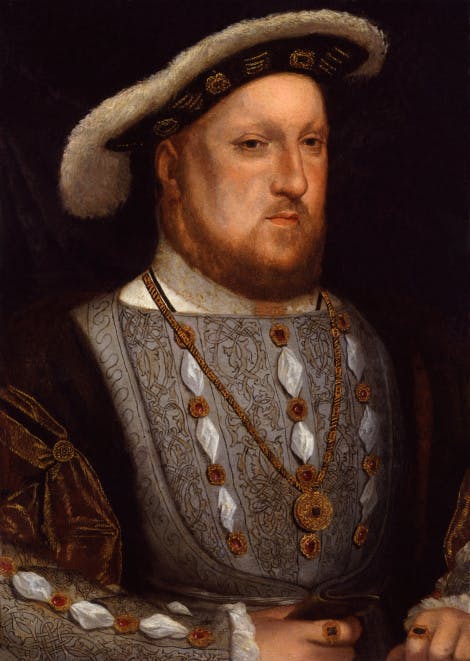
Henry VIII, Terrible Tudor?
Who was the real Henry VIII?
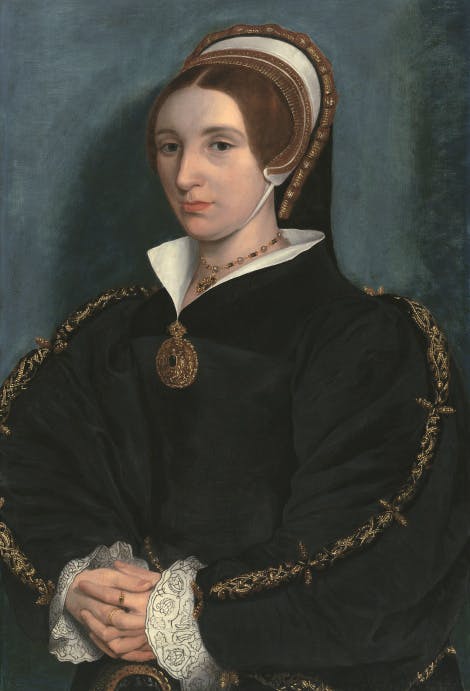
Catherine Howard
A young woman whose marriage to Henry VIII would end in tragedy
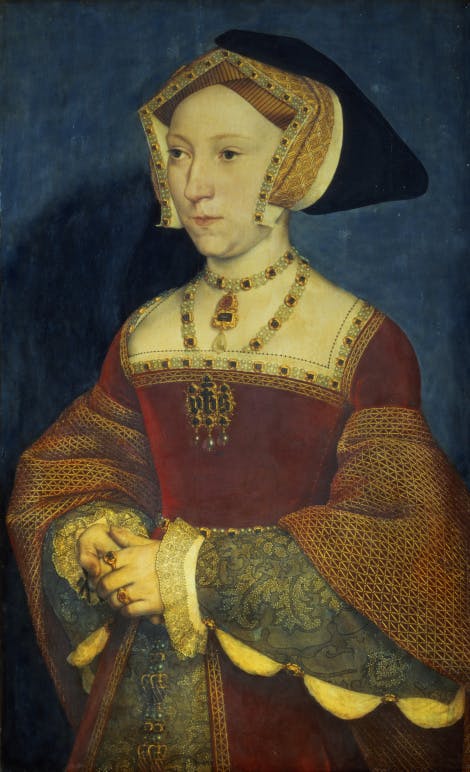
Jane Seymour
Henry VIII's favourite Queen?
Explore what's on

- Things to see
Great Hall
Experience the splendour of the Tudor court in Henry VIII's Great Hall, complete with his magnificent tapestries.
- Open
- In line with palace opening hours
- Hampton Court Palace
- Included in palace admission (Members go free)

- Things to see
Great Watching Chamber
Discover Henry VIII’s State Apartments and the battle for power at the Tudor court in the Great Watching Chamber.
- Open
- In line with palace opening hours
- Hampton Court Palace
- Included in palace admission (Members go free)

- Things to see
Chapel Court
Explore an opulent Tudor pleasure ground in the inner precincts of Hampton Court Palace.
-
In line with palace opening hours
- Hampton Court Palace
- Included in palace admission (Members go free)
Shop online

Christmas homepage banner - Henry VIII and Six Queens Decoration Set
Christmas Homepage Banner - Henry VIII and Six Queens hanging decoration set on a Christmas tree at Hampton Court Palace.
£70.00
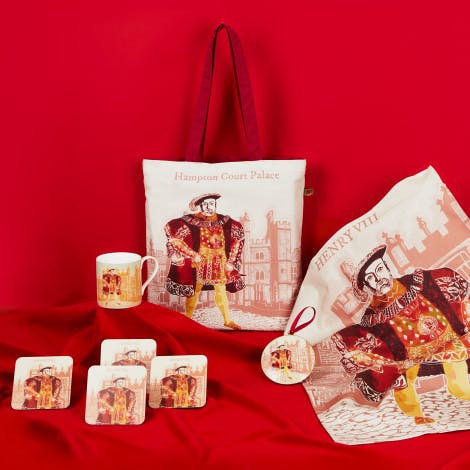
Shop Tudors
Find the perfect gift for collectors and history enthusiasts in our treasure trove of souvenirs inspired by this ever-fascinating dynasty.
From £3.00

Shop Goblets & Tankards
Discover our decadent range of goblets and tankards inspired by the palaces in our care, the perfect gift for any history fan.
From £10.00
